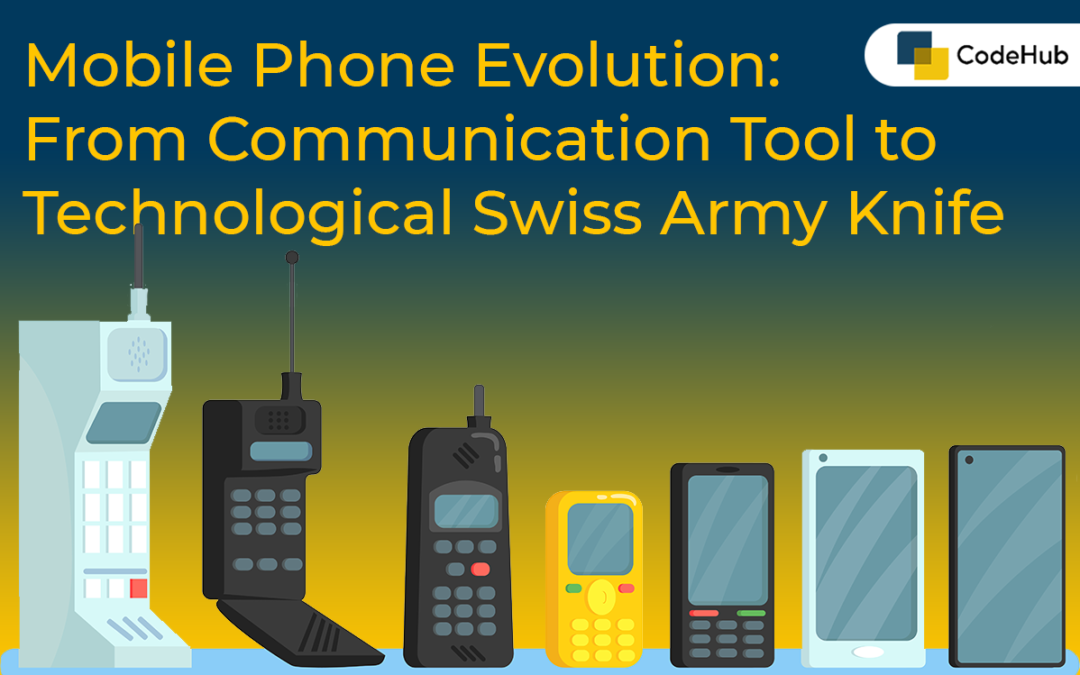Mobile phones have come a long way since their inception in the 1970s. What started as bulky and expensive devices that could only make and receive calls have evolved into sleek and powerful gadgets that can do much more than just communicate. Mobile phones have become technological Swiss Army knives that can perform various functions and tasks, such as browsing the web, taking photos, playing games, listening to music, watching videos, and accessing various apps and services. In this blog post, we will take a look at how mobile phones have evolved over the decades and what lies ahead for them in the future.
The First Generation: Analog Phones (1973-1991)
The first generation of mobile phones was based on analog technology that used radio waves to transmit voice signals. The first ever mobile phone was the Motorola DynaTAC 8000X, which was unveiled in 1973 by Martin Cooper, a Motorola engineer. It weighed 1.1 kg and had a battery life of 30 minutes. It cost $4000 USD and was considered a luxury item for the elite.
The first generation of mobile phones had many limitations, such as low voice quality, poor coverage, high power consumption, and susceptibility to interference. Moreover, they were only capable of making and receiving calls within a single network and had no roaming capabilities. They also had no display or keypad and required users to dial numbers manually.
The Second Generation: Digital Phones (1991-2001)
The second generation of mobile phones was based on digital technology that used binary codes to transmit voice and data signals. The second generation introduced the Global System for Mobile Communications (GSM), which is still the most widely used mobile network standard today. GSM enabled users to make and receive calls across different networks and countries, as well as send and receive text messages (SMS).
The second generation of mobile phones also introduced new features and designs, such as digital displays, keypads, SIM cards, batteries, antennas, and memory cards. Some of the iconic models of this era include the Nokia 1011 (the first mass-produced GSM phone), the Motorola StarTAC (the first clamshell phone), the Nokia 3310 (the best-selling phone of all time), and the Nokia 8110 (the “banana phone” featured in The Matrix).
The Third Generation: Smart Phones (2001-2010)
The third generation of mobile phones was based on broadband technology that increased the data transmission speed and capacity of mobile networks. The third generation introduced the Universal Mobile Telecommunications System (UMTS), which enabled users to access high-speed internet, multimedia messaging (MMS), video calling, and mobile TV on their phones.
The third generation of mobile phones also introduced new forms and functionalities, such as touchscreens, cameras, music players, GPS, Bluetooth, Wi-Fi, and mobile apps. Some of the influential models of this era include the BlackBerry Pearl (the first popular email phone), the Sony Ericsson T68i (the first phone with a color screen and a camera), the Motorola Razr (the thinnest phone at the time), the Nokia N95 (the first phone with a 5-megapixel camera and GPS), and the iPhone (the first phone with a multi-touch screen and an app store).
The Fourth Generation: Smartphones (2010-Present)
The fourth generation of mobile phones is based on LTE technology that further enhances the data transmission speed and quality of mobile networks. The fourth generation enables users to access ultra-fast internet, high-definition video streaming, cloud computing, augmented reality, and virtual reality on their phones.
The fourth generation of mobile phones also introduces new innovations and trends, such as artificial intelligence, biometric security, wireless charging, foldable screens, 5G connectivity, and blockchain technology. Some of the leading models of this era include the Samsung Galaxy S series (the best-selling Android phones), the iPhone X (the first phone with a notch and Face ID), the Huawei P20 Pro (the first phone with a triple camera), the Samsung Galaxy Fold (the first foldable phone), and the OnePlus 7 Pro (the first phone with a pop-up camera).
The Future of Mobile Phones: Beyond Smartphones
Mobile phones have evolved from simple communication tools to technological Swiss Army knives that can perform various functions and tasks. However, the evolution of mobile phones is not over yet. There are many possibilities and challenges that lie ahead for the future of mobile phones, such as:
- Wearable phones: Mobile phones may become wearable devices that can be integrated with clothing, jewelry, glasses, watches, or even implants. Wearable phones may offer more convenience, comfort, and personalization for users, as well as new ways of interacting with the environment and other devices. However, wearable phones may also raise issues of privacy, security, health, and social norms.
- Modular phones: Mobile phones may become modular devices that can be customized and upgraded by users according to their needs and preferences. Modular phones may consist of interchangeable components or modules that can be attached or detached easily. Modular phones may offer more flexibility, functionality, and sustainability for users, as well as reduce electronic waste and environmental impact. However, modular phones may also face challenges of compatibility, standardization, durability, and cost.
- Holographic phones: Mobile phones may become holographic devices that can project 3D images and videos in mid-air. Holographic phones may offer more immersive and realistic experiences for users, as well as new possibilities for entertainment, education, and communication. However, holographic phones may also require advanced technology, infrastructure, and power consumption, as well as pose ethical and social implications.
Mobile phones have come a long way since their inception in the 1970s. They have transformed from simple communication tools to technological Swiss Army knives that can do much more than just communicate. They have also influenced various aspects of our lives, such as culture, economy, society, and environment. As mobile technology continues to advance and innovate, we can expect mobile phones to become even more powerful, versatile, and ubiquitous in the future.

